Solomon’s Temple and then Herod’s Temple were built on Mount Moriah. The prophesied future Temple will also be built on Mount Moriah (see Malachi 3:1; and Ezekiel 37: 26-27, 47: 1; Isaiah 2: 2-3; and Revelation 11: 1). The name Moriah is a contraction of “mor” meaning to see, and “iah/jah” meaning Jehovah. Thus the name means the place where the Lord would be seen. The Lord tested Abraham by commanding him to offer up Isaac as a sacrifice on Mount Moriah (see Genesis 22: 2).
Today the Temple Mount is also known at Har HaBayit in Hebrew (meaning Mount of The House), and Haram al-Sharif in Arabic (meaning Noble Sanctuary). It and the adjoining Western Wall is the holiest site in Judaism. In Islam it is the third holiest site after Mecca and Medina. It is also a revered site in Christianity.
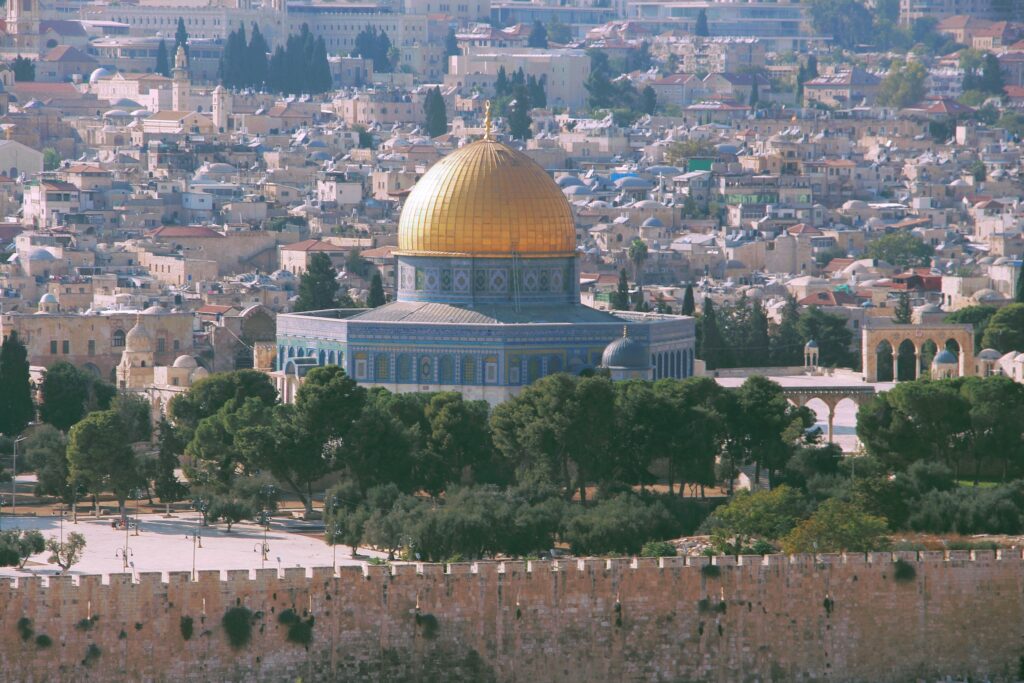
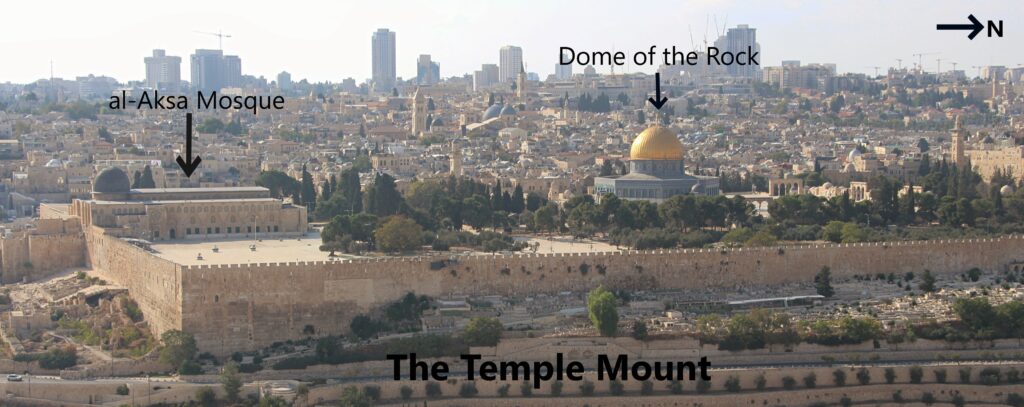
When the visitor first enters the Temple Mount they will be on the lower level near the al-Aksa Mosque (alternate spelling is al-Aqsa and means in Arabic “the furthermost”). This mosque is over the area where King Herod built the Royal Porch where the Sanhedrin met at the time of Christ. The mosque is built on the foundations of a Byzantine church built by Emperor Justinian in 536 AD. The first mosque built on the site was in 709-715 AD. In 1099 AD the mosque was converted by the Knights Templar crusaders into their international headquarters. The mosque has been destroyed by earthquakes and rebuilt several times. Currently, the mosque is the main place for group prayers, although when the mosque is full the entire open area of the mount can hold up to 400,000 worshipers.

The above picture is the Temple Mount after dusk with all of its flood lights on. The southern section of the Mount of Olives is in the background.

The above photo shows the southern staircase leading from the al-Aksa Mosque on the lower lever up to the upper level and the Dome of the Rock. The upper platform is a large artificially flat plaza. The plaza makes it easier for Muslims to gather for group prayer. Notice the free standing arches. There are a total of eight of these arched entrances up onto the upper platform where the Dome of the Rock is located. Muslim tradition says that all souls will be weighed by scales hung from these arches at the final judgment.

The Dome of the Rock is only used for individual Muslim prayers. Currently non-Muslims are not allowed in, which is a real shame as it is beautiful inside. Speaking of prayers, only Muslims are allowed to pray on the Temple Mount. If caught, Jews and Christians can be arrested by the Muslim security guards, called Waqf. The Dome of the Rock was built 687-691 AD by Caliph Abd al-Malik. It was used by the crusaders as a church in 1099 AD. It was then refurbished and beautified by the Muslim, Suleiman the Magnificent, in 1528 AD. The dome is built over a large rock which is the summit of Mount Moriah. Jewish tradition says the rock is the center of the earth. It possibly formed the foundation for the Temple altar for burnt offerings. The 17th chapter of the Quran says that Mohamed went to heaven from this rock during a “night journey.” There is no evidence that Mohamed ever left Arabia.
The purpose of the Dome of the Chain is unknown. It is believed to have been built about the same time as the Dome of the Rock. The Dome of the Ascension is an alternate spot where Mohamed ascended to heaven. It might have been built by the Crusaders and used as a baptism font structure and later repurposed by the Muslims. Or perhaps was built later than the Crusaders and reused Crusader columns? The Prayer Dome (or niche) of the Prophet Muhammad contains a direction marker toward Mecca. The so-called Dome of Hebron is not ancient.
This photo was taken in a southerly direction. See the next photo taken from between the Prayer Dome and Ascension Dome, but looking northward.
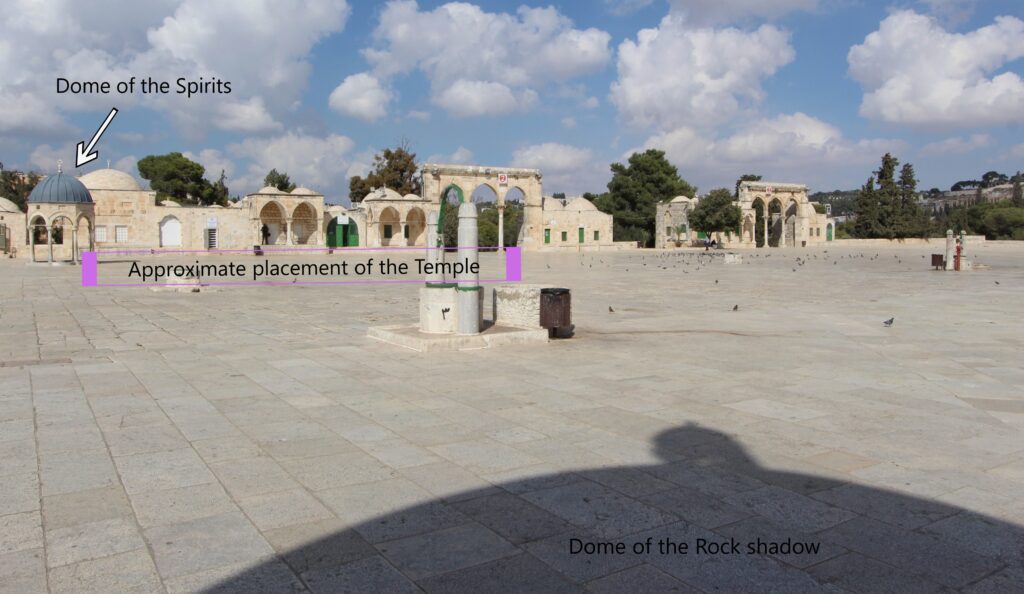
Looking at the northern upper plaza, the Dome of the Spirits (or of the Wind) dates from the 1500’s. The significance of this area is most likely the location of the two previous temples. It is thought that the temple entrance aligns with the Golden Gate (off the picture to the right). The exact location will not be known until archeologists are allowed to dig under the paving stones. That said, the temple was probably in this area and aligned from right to left (east to west). See the next photo of the Golden Gate.
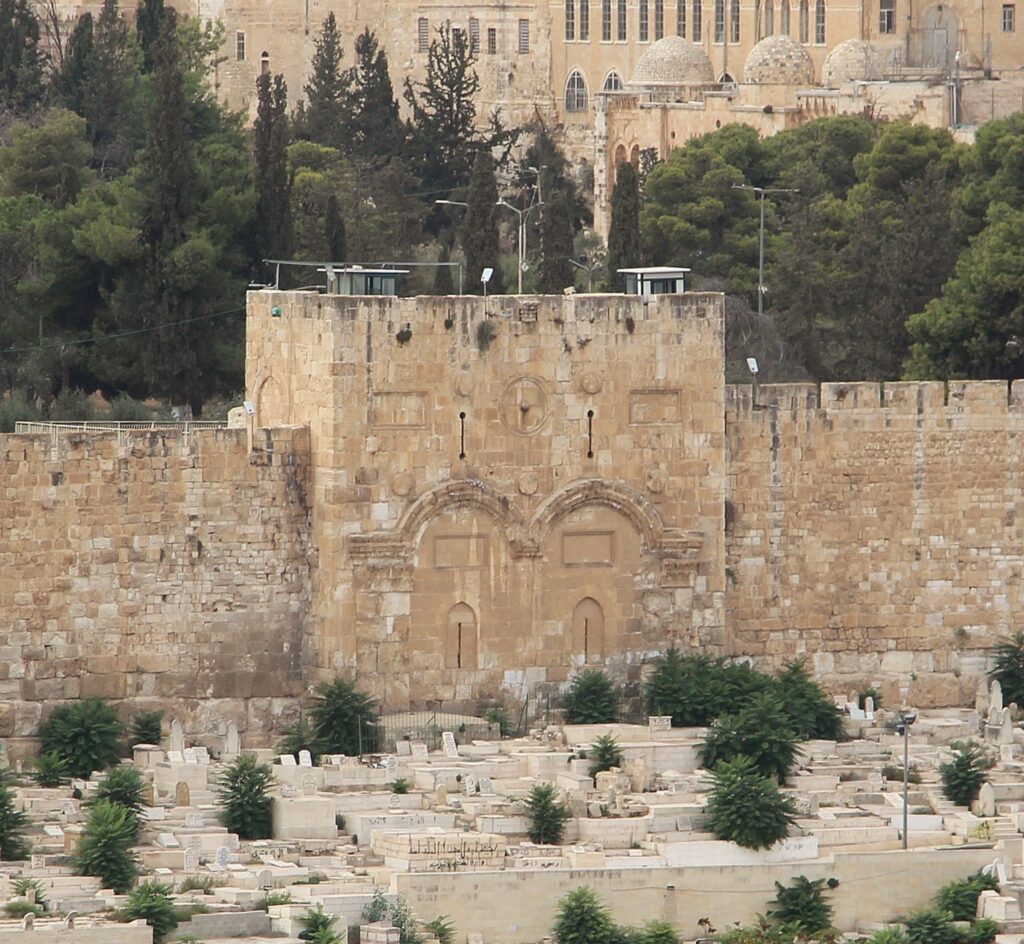
The Golden Gate lies between the Temple Mount and the Mount of Olives, with the Kidron Valley (also called Cedron in John 18:1) in between. In the foreground is a Muslim cemetery, and behind the gate the trees lie between the Gate and the Temple Mount’s upper plaza. The Golden Gate is also called the Eastern Gate and the Gate of Mercy. Some Christians believe that when Christ comes again He will enter through this gate (see Ezekiel 44:1-3). There is a tradition that because of this belief, Suleiman the Magnificent had the gate walled up when he rebuilt the walls of Jerusalem in 1536 AD. Below, let’s now move backward in time to the Temple Mount of the New Testament.
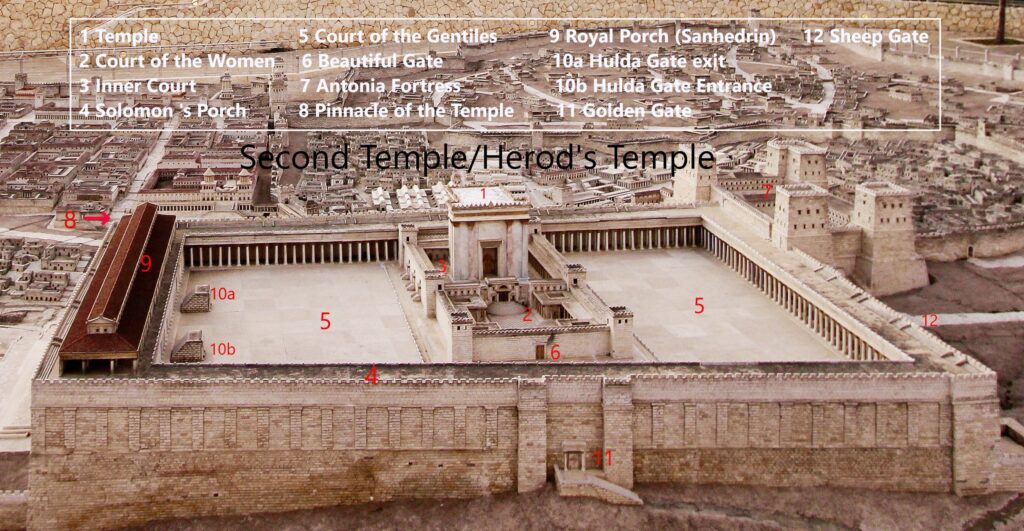
This is a photo I took of the Israel Museum’s scale model of Jerusalem before its destruction in 70 AD. The annotations were added by me.
The placement of the Second Temple/Herod’s Temple is on the exact same spot of the First Temple/Solomon’s Temple. Here is a slightly confusing historical footnote: some scholars refer to Solomon’s Temple as the First, and Zerubbabel’s Temple as the Second (the Temple rebuilt by the Jews when they returned from Babylon about 520 BC, see Ezra 3:3), and Herod’s Temple as the Third Temple. All three were built on the same spot, renovating the remains of the previous Temple. However, Herod greatly enlarged the complex surrounding the Temple. While scholars have named the three Temples after their different builders, it is important to remember that the real name for all of them is The House of the Lord (see 2 Chronicles 29:5; Psalms 23:6; Isaiah 2:2, Matthew 12:4; and John 2:16).
The above photo graphic: This is the best guess of what archeologists at the Israel Museum believe Herod’s Temple looked like. #1 is the Temple proper. Consisting of a porch, large inner sacred room containing the Menorah, table of shewbread, and an incense altar. The third room, the Holy of Holies, was separated from the inner sacred room by a large decorated curtain.
#2 is the Court of Women. It is the closest Israelite women could get to the Temple. Women could look through the door (called Gate of Nicanor) leading to the inner court to watch their families sacrifice on the altar.
#3 is the Inner Court, also known as the Court of Men/Court of the Priests. It was in this court that the great altar stood for burnt offerings as well as other types of offerings.
#4 is a long colonnaded portico called Solomon’s Porch. It resembled the colonnaded porch (visible in this photo) opposite across the court of the gentiles. This porch/cloister is on the eastern side of the Temple complex. It was in this porch that Jesus plainly proclaimed to the Jews that He was the Son of God (see John 10:22-39). Here Peter was found by the crowd after he had healed a lame man at the nearby Beautiful Gate (see Acts 3:2-11, see also Acts 5:12).
#5 is the Court of the Gentiles, the closest place where non-Israelites were allowed in. The Northern Court of Gentiles (on the right above) is the possible location for the selling of sacrificial animals as well as the money changers. It was possibly there where the Lord drove out the money changers and sellers (see Matthew 21:12; Mark 11:15; and John 2:14).
#6 is the Beautiful Gate, the entrance into the Court of the Women. As mentioned in #4 above, it was here at the gate that Peter, accompanied by John, healed a man that was lame from birth (see Acts 3:2-11).
#7 is the Antonia Fortress built by Herod the Great as a military garrison and named after Mark Anthony. At the time of Christ it was the main Roman garrison at Jerusalem. From the fort’s towers the soldiers could keep an eye on happenings in the Temple complex.
#8 is the most likely location for the Pinnacle of the Temple. See my next blog post which is all about the Pinnacle of the Temple (due out in two days. When it comes out there will be a link below).
#9 is the Royal Porch also called the Royal Stoa. It was a long Hall of 162 Columns arranged in four rows. Most scholars believe that the Sanhedrin met here.
#10 are the Hulda Gates. Gate #10a was the exit and Gate #10b was the entrance. The gates were staircases under the Royal Porch that led to the City of David below. According to later rabbis, everyone orderly entered and exited the correct gate. However, a person in mourning would enter and exit the wrong gates in order to signal they were in mourning and thereby receive comfort from those coming the correct way.
#11 is the original Golden Gate (not the one currently standing).
#12 is the Sheep Gate. So called because the sacrificial lambs would be brought through this gate from the Pool of Bethesda where they had been washed in preparation to be offered up as a sacrifice on the altar.
< Previous Post on Capernaum “His own city”
Next Post on The 3 Temptations of Christ >
Return to Homepage
4 responses to “The Temple Mount of Jerusalem”
Dennis, great research on this area. After all these years, I stand corrected on the location of the pinnacle of the temple. I had thought it was the front corner. I’m amazed that after all the thousands of years of destruction that there is even a level surface to build on, considering where the Golden Gate lies in relation to the current level. As well as the current Herods Gate versus the original location below. Or was it the Damascus Gate? It’s been too long…. For so many years I didn’t want to return because of the idea that it would spoil my original trip…that it would never be the same as living there and studying there. It was such a sacred time….
So, I haven’t gone back. I see now that I should have returned with Bro Brown…and now that he’s older, and with the war, there may never be another chance. Perhaps the time will open up again…. There’s a lot more to happen in this holy land.. last summer we were on a Mediterranean cruise, and as we were near Venice, we discovered that the cruise was going on to Israel! Although short, we never knew that it was going there! How did we miss it? But, at least my husband returned to Italy, the place of his mission, and enjoyed its culture, people and language once again! Thanks again for your blog!
Thank you Liz, I understand about not wanting to spoil the experience we had all those years ago. I can say each visit will not be the same as the last visit. However, there are new discoveries made all the time and new Biblical sites that open to the public all the time. There is always more to learn so you should take your husband. He needs to experience the land too.
Your memory of the old verses present elevation of an Old City gate is the Damascus Gate as it shows the excavated gate below the present gate. The pinnacle of the temple will be prominent in my next post on the “temptations of Christ.” Stay tuned, it will should be out Wednesday.
Love this! Thank you for sharing! We want to go on one of your tours sometime.
Nancy, thank you. I hope you will join me on a tour. I will announce it on my website when the war ends.